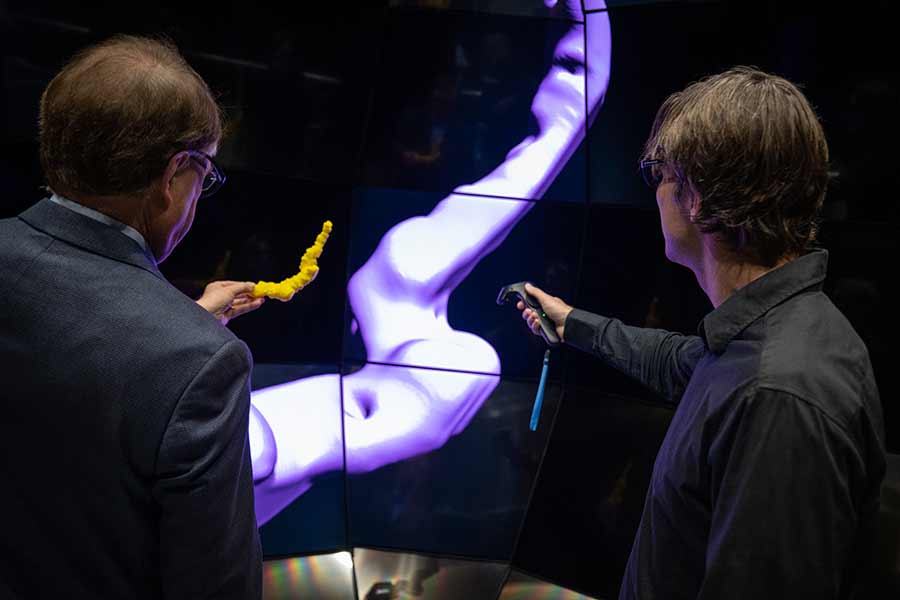
Two grants aim to advance more personalized treatments for patients
Dr. Pradipta Ghosh, Soumita Das, Larry Smarr and Jürgen Schulze—researchers in diverse disciplines at the University of California San Diego—will aim to improve surgical outcomes and therapeutics for Crohn’s disease patients through $4.7 million in new grants from The Leona M. and Harry B. Helmsley Charitable Trust. Helmsley’s goal is to find a cure for Crohn’s disease, a long-term pursuit in parallel with improving patients’ lives today.
“UC San Diego is pursuing innovative ideas that align with Helmsley’s goal of advancing precision medicine for Crohn’s disease patients,” said Garabet Yeretssian, director of Helmsley’s Crohn’s Disease Program. “Researchers at UC San Diego are at the forefront of developing more individualized therapeutics for people with Crohn’s disease and improving lives.”
Crohn’s disease is a chronic inflammatory disease of the gastrointestinal tract, the symptoms of which include persistent diarrhea, internal bleeding and chronic pain. In the United States, 201 of every 100,000 individuals suffer from the disease, and these numbers are steadily rising. The incidence and prevalence of Crohn’s disease are increasing rapidly in developing countries, attributed largely to the swift modernization and westernization of society. There is an urgent need to prevent, diagnose early and reconcile the most effective and appropriate treatments for patients.
A $3.5 million grant will allow Ghosh, professor and director of the Center for Network Medicine at UC San Diego School of Medicine, and Das, assistant professor, chief scientific officer and director of HUMANOID Center of Research Excellence at UC San Diego School of Medicine to assemble a transdisciplinary team of cellular, molecular and stem-cell biologists along with computer science engineers, pathologists and gastroenterologists. Together, they will build and validate a stem cell-based “gut-in-a-dish” model of Crohn’s disease, as a “Phase 0” human model before clinical trials.
The stem cells will be derived from intestinal biopsies of patients with the disease and used to reverse-engineer the gut lining. The model will encompass the microbes, immune cells and other complex cell types found in the gut.
“This approach will help us to predict an individual’s response to therapeutics and, thus, personalize treatments—reducing the chances he or she will be prescribed a drug that won’t work or might have negative side effects,” said Ghosh.
“At present, there is no cure for Crohn’s disease, and we believe our cutting-edge stem-cell based disease model will precisely identify effective treatment options, predict the outcome of clinical trials and provide the patients a high quality of life,” said Das.
With $1.2 million in funding, a team of researchers from the California Institute for Telecommunications and Information Technology (Calit2) at UC San Diego will refine existing software used to translate two-dimensional (2D) medical imagery into interactive three-dimensional (3D) images that better reveal the common occurrence of strictures, narrowing and/or twisting of the small and large intestines, in Crohn’s disease patients.
Traditionally, surgeons rely upon radiologists’ readings of the 2D magnetic resonance imaging (MRI) and computed tomography (CT) scans to map out the digestive tract and treatment plan. However, the lack of detail can increase the probability that a patient will need to undergo several invasive procedures before medical professionals identify the most appropriate one. To support pre-operative planning, the team at UC San Diego will create a dynamic 3D model using the patient’s own MRI and/or CT 2D data. Results of this pilot project could improve surgical outcomes, as well as improve patient experience and understanding of the illness. With this enhanced knowledge, patients and surgeons can plan the most effective intervention based on their own unique anatomy.
“Our team developed the initial software to support my own surgical sigmoid colon resection in 2016. While working with my medical team using our one-off 3D representations of my colon, it quickly became evident that what was needed is a tool to enable doctors and surgeons to work routinely in the 3D reality of their patients,” said Larry Smarr, director of Calit2 and principal investigator on the project—and a Crohn’s disease patient himself. “Helmsley’s support will allow us to further develop the software and understand how its use can improve outcomes for patients.”
The pilot project brings together a unique cross-disciplinary team of doctors, surgeons, radiologists and computer scientists, including Jürgen Schulze, an associate research scientist with Calit2’s Qualcomm Institute and a leading authority on developing software for application of immersive virtual reality to medical situations.
“The software system we are going to develop, along with the entire data processing pipeline from MRI or CT image acquisition to a detailed 3D model of the colon, is going to allow surgeons to plan exactly what they need to do during surgery for Crohn’s disease patients. Our approach may well be applicable to other diseases in the future,” said Schulze.
